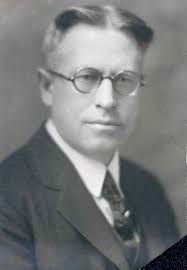Fromm Self-Guided Tours
Employees
Dr. Green
Dr. Green and the Fromm Fox Ranches::
Facts re Disease Problem at Fromm Fox Ranches and Initial Disease Control Work of R. G. Green
In the winter of 1921, which was prior to the incorporation of any of the above-mentioned corporations, the Fromm brothers began to experience deaths in their silver fox herds, which they attributed to the incidence of disease. This situation continued also in subsequent years. The Fromms were unable to identify the particular type of the suspected disease; and they could find no medical preparation which would meet their problem.
Subsequently in the summer of 1924, Robert Gladding Green, M. D., who was a member of the faculty of the University of Minnesota in its department of bacteriology and immunology, visited the Fromm brothers’ fur ranch at Hamburg. He told the Fromms that he had learned of their disease problem; that he was interested in the subject of animal diseases; and that he would like to undertake a study of the fox disease which was confronting them. The Fromm brothers thereupon arranged with Green to undertake diagnosis and study of the suspected disease, and to attempt to find a method for controlling it. Green undertook this work without any formal agreement being entered into, except that the Fromms would from time to time supply him both with live foxes and with carcasses of deceased foxes for use in his study, and also with funds to cover his expenses.
Green continued to be a member of the faculty of the University of Minnesota until his death in 1947; but subsequent to 1924 he devoted a substantial portion of his time to work with the Fromm brothers and the subsequently organized Fromm fur corporations, on problems pertaining to the health of their fur-bearing animals. Most of this work was carried on by him and his associates at Millard Hall on the campus of the University of Minnesota. The foxes supplied to him by the Fromms for use in his study, were initially kept by him in retention pens located on premises which he owned at Hager City, Wisconsin, and also on other premises located at Lake Alexander, Minnesota — both of which premises were only a short distance from the University, but several hundred miles from the Fromm ranches. Later, in about 1934, his use of the facilities at Hager City was discontinued in favor of more extensive space within which to keep such animals, on the ranch of Fromm Bros. Inc. at Hamburg. And subsequently in 1935, the use of these Hamburg facilities likewise was discontinued in favor of still more adequate facilities on a ranch at Grafton, Wisconsin (located about 5 miles from Thiensville), which was purchased in 1935 by the Fromm-Nieman corporation. This latter property, known as “Lakefield,” is hereinafter more fully described.
Within a relatively short time after Green began his diagnostic work in 1924, he concluded that one of the diseases afflicting the Fromm silver foxes was “fox encephalitis.” He thereupon developed a serum for the prevention and treatment of this disease, by a method which was substantially as follows. First, live encephalitis virus, obtained from the tissues of silver foxes which had died of that disease, was injected into a selected group of red foxes. The result was that some of this group of red foxes died of the disease, but those which survived developed protective anti-bodies in their blood, which tended to protect them. Thereafter, at biweekly intervals extending over a period of about one year, additional injections of encephalitis virus would be given the surviving red foxes; and such repeated injections had the effect of ultimately creating a maximum concentration of protective antibodies in their blood, which made them “hyper-immune.” Blood of these hyper-immune red foxes was then drawn off, allowed to coagulate, and thereupon put into a centrifuge which extracted the serum containing the anti-bodies. The serum so produced could thereafter be used, either as a prophylactic for conferring immunity on
[19 T.C.M. 1063]
non-diseased foxes, or as a remedy for the treatment of encephalitis in infected animals. As hereinafter shown, large amounts of such serum were used from about 1929 to 1939 to inoculate most of the silver fox pups of the four Fromm fur corporations, without any separate charge being made therefor.
During the time that Green was carrying on such work with respect to encephalitis, he concluded that another disease which existed in the Fromm silver fox herds, was “distemper.” Thereupon, by using substantially the same techniques which he had employed in producing the serum for fox encephalitis, he developed a serum for fox distemper. During 1936 or 1937, this distemper serum likewise was used to inoculate the Fromm fox herds, without any separate charge being made therefor.
Up until 1929 when Fromm Bros. Inc. and the Fromm-Nieman corporation were organized, the four Fromm brothers paid all the expenses and furnished all of the animals incident to Green’s work at the University of Minnesota. Thereafter, from 1929 through 1944, substantially all of Green’s expenses at the University of Minnesota and also certain amounts paid to him and his associates as salary, were paid initially either by Fromm Bros. Inc. or by the Fromm-Nieman corporation; and the same were then, at least from 1933 through 1944, allocated among all four of the Fromm fur corporations on the basis of the number of breeder animals which each owned. The amounts so allocated were then, as in the case of the other expenses above mentioned, taken by these corporations into their books of account as current operating expenses, and were deducted by them as operating expenses on their Federal income tax returns.
